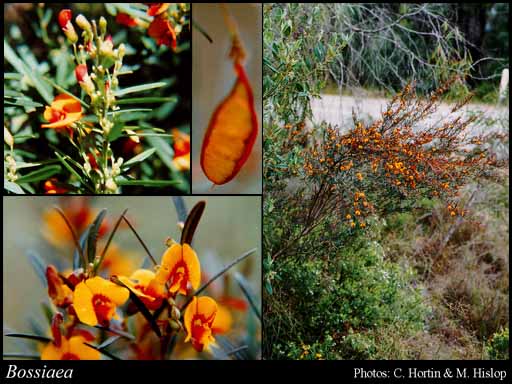- Reference
- Descr.Pl.Nouv. 7,Pl.7 (1800)
- Name Status
- Current

Scientific Description
Family Papilionaceae. Bossiaeae.
Habit and leaf form. Shrubs (or subshrubs). ‘Normal’ plants, or switch-plants; the switch forms with the principal photosynthesizing function transferred to stems (the branches terete, compressed into cladodes, two-winged or subangular). Leaves well developed, or much reduced, or absent (at least, sometimes ‘almost so’, e.g. B. rufa). Plants prickly (via leaves, e.g. B. aquifolium), or spiny (e.g. B. spinescens), or unarmed. The spines when present, axial. Mesophytic, or xerophytic. Leaves minute to medium-sized; alternate (usually), or opposite (e.g. B. aquifolium); spiral, or distichous; with blades, or bladeless; ‘herbaceous’, or leathery, or membranous; not imbricate; petiolate to sessile; non-sheathing; simple; pulvinate (usually), or epulvinate (when reduced to scales?). Leaf blades dorsiventral, or isobilateral; dissected (‘dentate’), or entire. Leaves with stipules, or without stipules (‘small or absent’). Stipules intrapetiolar; scaly (to subulate or setaceous); caducous, or persistent. Leaf blade margins entire, or dentate; prickly (e.g. B. aquifolium), or not prickly. Leaves without a persistent basal meristem. Stem anatomy. Nodes tri-lacunar, or penta-lacunar. Secondary thickening developing from a conventional cambial ring.
Reproductive type, pollination. Fertile flowers hermaphrodite. Unisexual flowers absent. Plants hermaphrodite. Entomophilous, or ornithophilous. Pollination mechanism conspicuously specialized.
Inflorescence and flower features. Flowers solitary, or aggregated in ‘inflorescences’; not crowded at the stem bases; when solitary (i.e. usually), axillary; 1–3 per axil; when aggregated, in fascicles. Inflorescences axillary. Flowers pedicellate; bracteate; (bi-) bracteolate (and subtended by papery brown scales in addition to the similar bract and bracteoles), or ebracteolate (B. pulchella). Bracteoles persistent (and small), or deciduous (and large). Bracteoles not adnate to the receptacle. Flowers minute to medium-sized; very irregular; zygomorphic. The floral asymmetry involving the perianth, or involving the perianth and involving the androecium. Flowers papilionaceous (imbricate-descending, with the posterior petal outside and forming a flag (‘standard’)); basically 5 merous. Floral receptacle developing a gynophore, or with neither androphore nor gynophore. Free hypanthium present, or absent. Perianth with distinct calyx and corolla; 10; 2 -whorled; isomerous. Calyx present; 5; 1 -whorled; gamosepalous; (5) lobed. Calyx lobes markedly shorter than the tube, or about the same length as the tube, or markedly longer than the tube. Calyx imbricate, or valvate; exceeded by the corolla; bilabiate (the two posterior lobes broad, more or less separate or connate to above the middle, the anterior three small or minute); persistent; with the median member anterior. Epicalyx absent. Corolla present; 5; 1 -whorled; appendiculate, or not appendiculate. Standard not appendaged. Corolla partially gamopetalous. 2 of the petals joined (the two ventral petals connivent to form the ‘keel’). The joined petals of the papilionate corolla anterior. The wings of the corolla free from the keel; not laterally spurred. Standard ‘normally’ developed (often reflexed); entire, or emarginate (orbicular or reniform); not sericeous. Keel conspicuously exceeded by the wings to about equalling the wings (the keel petals broader than the oblong wings, shorter or longer than the standard); not long-acuminate/beaked (blunt); neither coiled nor spiralled; not bent and beaked. Corolla imbricate (descending); yellow, or red, or purple, or brown (or combinations of these, commonly yellow and brown); persistent, or deciduous; non-accrescent. Petals long clawed. Androecial members definite in number. Androecium 10. Androecial sequence determinable, or not determinable. Androecial members free of the perianth; all equal, or markedly unequal; coherent (into an adaxially split sheath); 1 - adelphous (or rarely with some flowers exhibiting a free vexillary stamen). The staminal tube free from the keel petals. Androecial members 1 -whorled (even though diplostemonous). Androecium exclusively of fertile stamens. Stamens 10; all more or less similar in shape; diplostemonous; both opposite and alternating with the corolla members. Anthers separate from one another, or connivent; all alike (with a perceptible brown connective); all dorsifixed; versatile; dehiscing via longitudinal slits; introrse; tetrasporangiate. Pollen shed as single grains. Gynoecium 1 carpelled. The pistil 1 celled. Carpels reduced in number relative to the perianth. Gynoecium monomerous; of one carpel; superior. Carpel stylate; apically stigmatic. Style (in-) curved. Style terete (subulate). Style glabrous. Stigmatic tissue terminal. Carpel (2–)4–25 ovuled (‘to many’, or ‘several’). Placentation marginal (along the ventral suture). Gynoecium median (the placenta posterior, on the ventral suture). Ovary sessile to stipitate. Ovary summit glabrous, or hairy, the hairs not confined to radiating bands. Ovules pendulous to ascending; biseriate; arillate; anatropous, or campylotropous to amphitropous, or hemianatropous.
Fruit and seed features. Fruit shortly stipitate, or subsessile to sessile; non-fleshy; hairy, or not hairy. The fruiting carpel dehiscent; a legume. Pods somewhat elongated to much elongated; not triangular; not becoming inflated; more or less flat (usually), or somewhat compressed; transversely septate between the seeds, or not transversely septate; wingless (though sometimes with a thick narrow keel beyond the adaxial sutural nerve). Valves of the dehisced pod not twisted (‘flat or nearly so’). Fruit 1 celled. Dispersal unit the seed. Fruit 2–20 seeded. Seeds endospermic, or non-endospermic; not mucous; compressed, or not compressed; small to medium sized; arillate (the aril hooded, caplike). Cotyledons 2; accumbent. Embryo curved to bent (the radicle inflexed). Testa non-operculate; homogeneous in colour, or conspicuously colour-patterned. Micropyle zigzag, or not zigzag.
Physiology, biochemistry. Aluminium accumulation not found. Photosynthetic pathway: C3.
Geography, cytology, number of species. Native of Australia. Endemic to Australia. Australian states and territories: Western Australia, South Australia, Northern Territory, Queensland, New South Wales, Victoria, Australian Capital Territory, and Tasmania. 2n=18. A genus of about 40 species; 23 species in Western Australia.